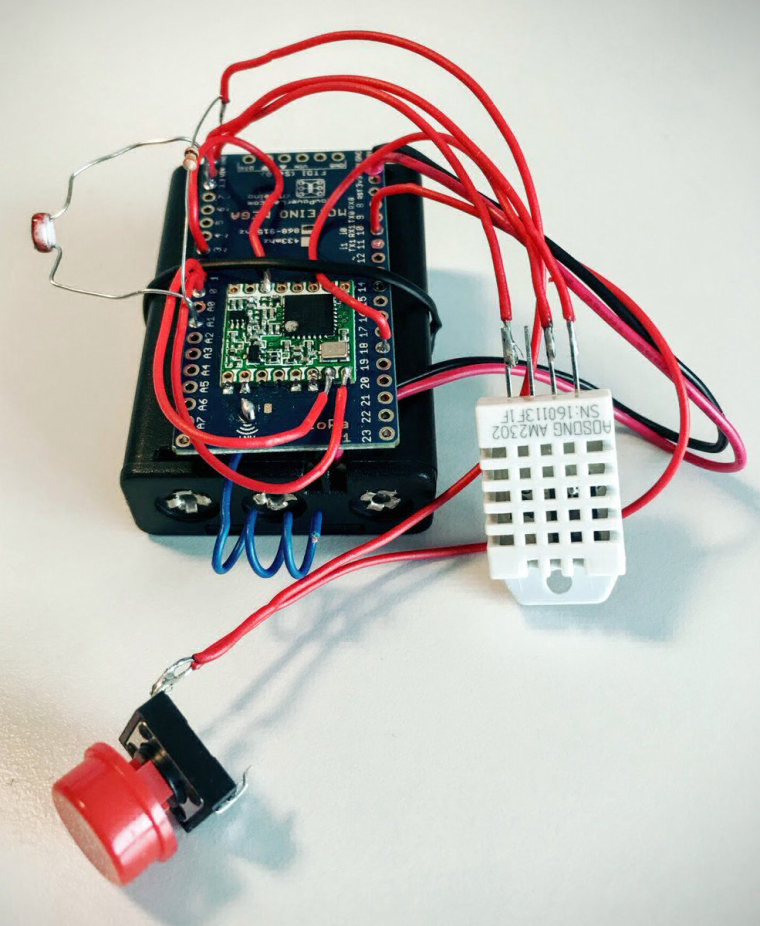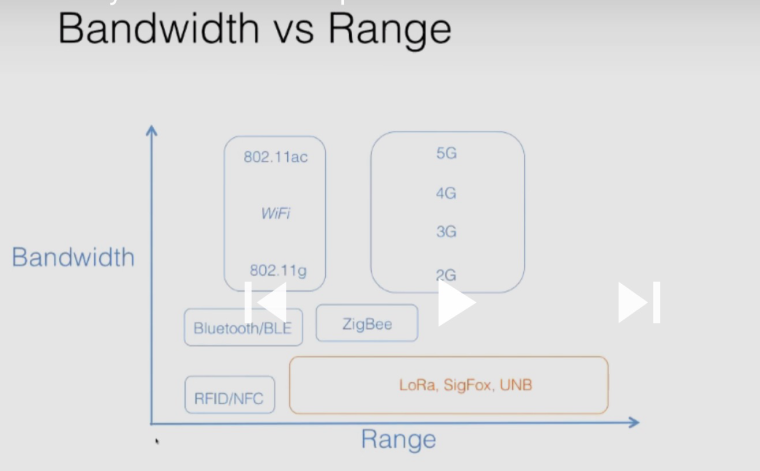Any RFM95 user reports?
-
I'm planning to get myself one of those and set it up in my neighborhood, however at least for the time being I find it a bit useless since I don't know of any Home <-> LoRaWAN gateway that would effectively push the end nodes data over the LoRa network and up to a hub. Moreover, if that gateway would exist, then there should be some considerations regarding the way the LoRaWAN gateway handles packets, eg. authentication, message signing, encryption, ACL or rate limiting. This would enforce a private communication channel, free of any abuser that would hammer down the gateway by sending readings every 5 sec. from a set of couple of dozen sensors, congesting the gateway.
It may be that some manufactures such as Cisco have already considered these but I'm not aware of that, and testing their solutions is rather cost prohibitive. -
The duty cycle limits combined with long send times makes it very hard to use LoRa for home automation. Having to wait 20-200 seconds (depending on frequency band) between messages is a severe limitation.
There are definitely some use cases where LoRa is still applicable, but I think the duty cycle is a big reason to why there are no gateways between LoRa and home automation systems.
A good thread on the limitations https://www.thethingsnetwork.org/forum/t/limitations-data-rate-packet-size-30-seconds-uplink-and-10-messages-downlink-per-day-fair-access-policy/1300
An airtime calculator is available at https://docs.google.com/spreadsheets/d/1voGAtQAjC1qBmaVuP1ApNKs1ekgUjavHuVQIXyYSvNc/edit?usp=sharing
-
I see, but the end nodes shouldn't necessary route their data in an a synchronous manner. The gateway can buffer the data and commit the reading asynchronously over to the LoRaWAN network once every 5 minutes. Sensor data downsampling could be performed by the gateway in order to shorten the TX window to the utmost minimum. Downsampling and/or a heavy compression algorithm could help.
On the other hand, I do realize that all these feature could lead to a fairly complex solution that's going to be so complicated to use that's never gonna get any traction. -
I don't see any good point is directly interfacing a home automation system with a LoRaWAN device: if you need to perform data collection or some remote control, the controller could take care of that without having bridges rfm69<->nrf24. As mentioned before, there is a community for Lora public GW https://www.thethingsnetwork.org/community that people could use maybe together with mqtt.
-
Anything concerning loraWAN is expensive and one has to develop it. This is probably good for developers aiming for a final product, for example, air sampling at the remote site without any internet access. However, even in this case 4G network can be used. If such site does not have internet / electricity, this is where loraWAN comes very handy
-
Indeed, I see LoRa as an option for either experimenting, or as a solid alternative where there's no other option. Because at the end of the day, those who'll require a reliable transport layer will not resort to the open bands but use 2G/3G modems or even radio modems or satellite uplinks. While the LoRaWAN users will have to cope with the drastic FAP limitations, or use point-to-point systems for setups that allows no alternative, like I do.
-
@gohan in a highly populated area Lora is better from my perspective. However, as already mentioned the cost is high (GW - €300, node - €55+ etc). Plus one is expected to develop
@alexsh1 said in Any RFM95 user reports?:
@gohan in a highly populated area Lora is better from my perspective. However, as already mentioned the cost is high (GW - €300, node - €55+ etc). Plus one is expected to develop
And why is that? Dense population = likely more users = frequent gw congestions.
-
@alexsh1 said in Any RFM95 user reports?:
@gohan in a highly populated area Lora is better from my perspective. However, as already mentioned the cost is high (GW - €300, node - €55+ etc). Plus one is expected to develop
And why is that? Dense population = likely more users = frequent gw congestions.
When I said Lora I'm referring to LoraWAN, which is not the same thing.
-
2G requires more power to transmit than LoraWAN
-
LoRaWAN is optimized for uplink (from the node to a server). For downlink there is 8 times less bandwidth available. This means it is designed to received info from sensors
-
A gateway can receive on 8 channels at the same time
All that said, the ideal use case for LoRaWAN is:
- Simple sensors that need to transmit infrequently
- Missing 5-85% of data at times is okay
- Little ability to control this device
- No ability to update device firmware over-the-air
- Deployed in the dozens to hundreds
Some Automatic Meter Reading is a great example of a good use case for LoRaWAN. For meters that update the reading, say once per hour, it does not matter if some readings are missed, as long as some make it through.
Finally, places like Amsterdam were completely covered by LoraWAN in just two weeks. There is no chance for the city of this size to be covered by 2G in such a short time.
-
-
@gohan in a highly populated area Lora is better from my perspective. However, as already mentioned the cost is high (GW - €300, node - €55+ etc). Plus one is expected to develop
Regarding the cost, I have built prototype nodes on Wemos D1 Mini + RFM96 using these clones and wire antennas:
http://www.ebay.com/itm/231784606792
https://www.aliexpress.com/item/D1-mini-Mini-NodeMcu-4M-bytes-Lua-WIFI-Internet-of-Things-development-board-based-ESP8266-by/32662942091.html -
Regarding the cost, I have built prototype nodes on Wemos D1 Mini + RFM96 using these clones and wire antennas:
http://www.ebay.com/itm/231784606792
https://www.aliexpress.com/item/D1-mini-Mini-NodeMcu-4M-bytes-Lua-WIFI-Internet-of-Things-development-board-based-ESP8266-by/32662942091.html@mfalkvidd when it comes to a loraWAN GW the cost is different - the DIY GW is going to set you off by €200+.
Rfm95/96 are cheap, but there are cheap for a reason. RN2483 is more expensive but it is loraWAN compliant.
-
@mfalkvidd when it comes to a loraWAN GW the cost is different - the DIY GW is going to set you off by €200+.
Rfm95/96 are cheap, but there are cheap for a reason. RN2483 is more expensive but it is loraWAN compliant.
-
@alexsh1 yes, absolutely. But is a private lorawan gw really relevant in a home automation scenario?
@mfalkvidd That's a loaded question. The same as NB-IOT, I think Lora may be used under certain circumstances in home automation though it is not designed for it.
For example, a friend of mine has got a summer house in a remote location. No internet and very weak 3G/2G signal. However, there is a loraWAN signal (it is in Holland). Of course, a good GSM antenna may help here. Or loraWAN can be used to send a message "all is OK with your house" once an hour. Is this home automation? Yes it is.
Like like yourself, I'm using Wemos D1 mini + rfm95 as a single channel GW and a few sensors just to tinker with this new technology and try to find the right application
-
Well, I'm glad that the posting got some traction and some very interesting ideas were shared. While the bits and pieces of information were all out there, your argument helped drawing some conclusions.
- LoRa is NOT an option for HA. alexsh1 explained one scenario and I'm actually using LoRa (not LoRaWAN) in my building, but both cases make use of LoRa only because it's a new cool technology. @alexsh1 your friend could properly cover his home with 2G/3G signal either for free, by asking the provider to improve the coverage in that area, or by buying a GSM repeater. And I could ask a neighbor to share his WiFi connection so an ESP8266 module could do the job.
- The protocol addresses very specific segments where a great urban coverage is required and for that to happen no node should exceed a radio power of over 100mW.
There is another case where everything was traded off for the sake of range, the ham radio JT65 protocol. I was able to successfully transmit a signal from Romania to Brazil using 5W RF power and a 1m diameter magnetic loop antenna. It's great for long distance, narrow bandwidth (200Hz wide channel), low power but it sends data at a "whooping" speed of 13 characters per 50 sec, during which it draws about 1.8A from a 12V battery (21.6Wh). - My original idea of LoRa <-> RFM69/RF24 is not feasible unless, some serious downsampling is involved, as buffering the raw data before sending it out is really useless because LoRa doesn't have a serious overhead that would be addressed by concatenating larger chunks of data in a single packets.
So at the end of the day, it really leaves us with a couple of applicable scenarios when taking public LoRaWAN meshes into consideration. Smart meters and perhaps security devices which only have to send a daily keepalive ping and if ever needed, tripped sensor alerts, provided that they would be immune to jammers. I'm not taking into consideration the close range stations where a daily 30s air time would suffice, because this defeats the purpose of LongRange. Other than that I see no real use of LoRaWAN, but feel free to share your ideas, perhaps I'm missing something.
And after apparently trashing both LoRa and LoRaWAN I will only say that I can barely wait to get myself a LoRaWAN gateway and set it up in my area :grin: :grin: :grin:



